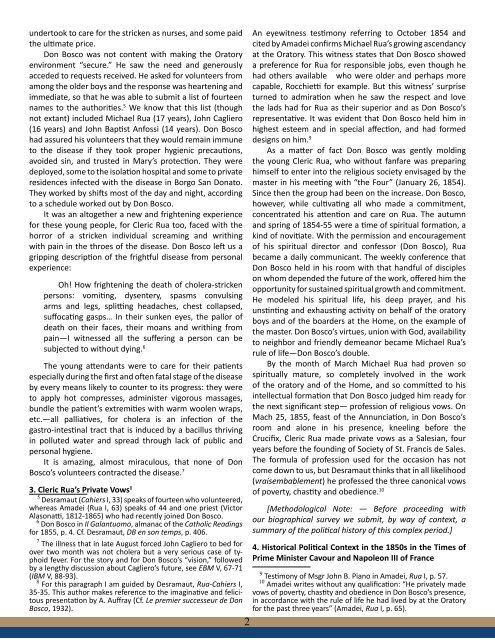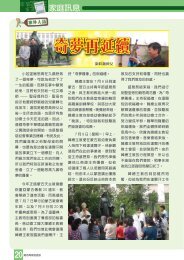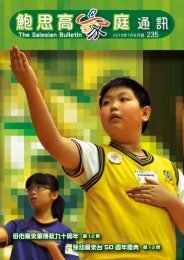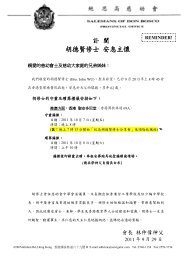San Francisco Province November 2009
San Francisco Province November 2009
San Francisco Province November 2009
Create successful ePaper yourself
Turn your PDF publications into a flip-book with our unique Google optimized e-Paper software.
undertook to care for the stricken as nurses, and some paid<br />
the ultimate price.<br />
Don Bosco was not content with making the Oratory<br />
environment “secure.” He saw the need and generously<br />
acceded to requests received. He asked for volunteers from<br />
among the older boys and the response was heartening and<br />
immediate, so that he was able to submit a list of fourteen<br />
names to the authorities. 5 We know that this list (though<br />
not extant) included Michael Rua (17 years), John Cagliero<br />
(16 years) and John Baptist Anfossi (14 years). Don Bosco<br />
had assured his volunteers that they would remain immune<br />
to the disease if they took proper hygienic precautions,<br />
avoided sin, and trusted in Mary’s protection. They were<br />
deployed, some to the isolation hospital and some to private<br />
residences infected with the disease in Borgo <strong>San</strong> Donato.<br />
They worked by shifts most of the day and night, according<br />
to a schedule worked out by Don Bosco.<br />
It was an altogether a new and frightening experience<br />
for these young people, for Cleric Rua too, faced with the<br />
horror of a stricken individual screaming and writhing<br />
with pain in the throes of the disease. Don Bosco left us a<br />
gripping description of the frightful disease from personal<br />
experience:<br />
Oh! How frightening the death of cholera-stricken<br />
persons: vomiting, dysentery, spasms convulsing<br />
arms and legs, splitting headaches, chest collapsed,<br />
suffocating gasps… In their sunken eyes, the pallor of<br />
death on their faces, their moans and writhing from<br />
pain—I witnessed all the suffering a person can be<br />
subjected to without dying. 6<br />
The young attendants were to care for their patients<br />
especially during the first and often fatal stage of the disease<br />
by every means likely to counter to its progress: they were<br />
to apply hot compresses, administer vigorous massages,<br />
bundle the patient’s extremities with warm woolen wraps,<br />
etc.—all palliatives, for cholera is an infection of the<br />
gastro-intestinal tract that is induced by a bacillus thriving<br />
in polluted water and spread through lack of public and<br />
personal hygiene.<br />
It is amazing, almost miraculous, that none of Don<br />
Bosco’s volunteers contracted the disease. 7<br />
3. Cleric Rua’s Private Vows 8<br />
5<br />
Desramaut (Cahiers I, 33) speaks of fourteen who volunteered,<br />
whereas Amadei (Rua I, 63) speaks of 44 and one priest (Victor<br />
Alasonatti, 1812-1865) who had recently joined Don Bosco.<br />
6<br />
Don Bosco in Il Galantuomo, almanac of the Catholic Readings<br />
for 1855, p. 4. Cf. Desramaut, DB en son temps, p. 406.<br />
7<br />
The illness that in late August forced John Cagliero to bed for<br />
over two month was not cholera but a very serious case of typhoid<br />
fever. For the story and for Don Bosco’s “vision,” followed<br />
by a lengthy discussion about Cagliero’s future, see EBM V, 67-71<br />
(IBM V, 88-93).<br />
8<br />
For this paragraph I am guided by Desramaut, Rua-Cahiers I,<br />
35-35. This author makes reference to the imaginative and felicitous<br />
presentation by A. Auffray (Cf. Le premier successeur de Don<br />
Bosco, 1932).<br />
2<br />
An eyewitness testimony referring to October 1854 and<br />
cited by Amadei confirms Michael Rua’s growing ascendancy<br />
at the Oratory. This witness states that Don Bosco showed<br />
a preference for Rua for responsible jobs, even though he<br />
had others available who were older and perhaps more<br />
capable, Rocchietti for example. But this witness’ surprise<br />
turned to admiration when he saw the respect and love<br />
the lads had for Rua as their superior and as Don Bosco’s<br />
representative. It was evident that Don Bosco held him in<br />
highest esteem and in special affection, and had formed<br />
designs on him. 9<br />
As a matter of fact Don Bosco was gently molding<br />
the young Cleric Rua, who without fanfare was preparing<br />
himself to enter into the religious society envisaged by the<br />
master in his meeting with “the Four” (January 26, 1854).<br />
Since then the group had been on the increase. Don Bosco,<br />
however, while cultivating all who made a commitment,<br />
concentrated his attention and care on Rua. The autumn<br />
and spring of 1854-55 were a time of spiritual formation, a<br />
kind of novitiate. With the permission and encouragement<br />
of his spiritual director and confessor (Don Bosco), Rua<br />
became a daily communicant. The weekly conference that<br />
Don Bosco held in his room with that handful of disciples<br />
on whom depended the future of the work, offered him the<br />
opportunity for sustained spiritual growth and commitment.<br />
He modeled his spiritual life, his deep prayer, and his<br />
unstinting and exhausting activity on behalf of the oratory<br />
boys and of the boarders at the Home, on the example of<br />
the master. Don Bosco’s virtues, union with God, availability<br />
to neighbor and friendly demeanor became Michael Rua’s<br />
rule of life—Don Bosco’s double.<br />
By the month of March Michael Rua had proven so<br />
spiritually mature, so completely involved in the work<br />
of the oratory and of the Home, and so committed to his<br />
intellectual formation that Don Bosco judged him ready for<br />
the next significant step— profession of religious vows. On<br />
Mach 25, 1855, feast of the Annunciation, in Don Bosco’s<br />
room and alone in his presence, kneeling before the<br />
Crucifix, Cleric Rua made private vows as a Salesian, four<br />
years before the founding of Society of St. Francis de Sales.<br />
The formula of profession used for the occasion has not<br />
come down to us, but Desramaut thinks that in all likelihood<br />
(vraisembablement) he professed the three canonical vows<br />
of poverty, chastity and obedience. 10<br />
[Methodological Note: — Before proceeding with<br />
our biographical survey we submit, by way of context, a<br />
summary of the political history of this complex period.]<br />
4. Historical Political Context in the 1850s in the Times of<br />
Prime Minister Cavour and Napoleon III of France<br />
9<br />
Testimony of Msgr John B. Piano in Amadei, Rua I, p. 57.<br />
10<br />
Amadei writes without any qualification: “He privately made<br />
vows of poverty, chastity and obedience in Don Bosco’s presence,<br />
in accordance with the rule of life he had lived by at the Oratory<br />
for the past three years” (Amadei, Rua I, p. 65).







